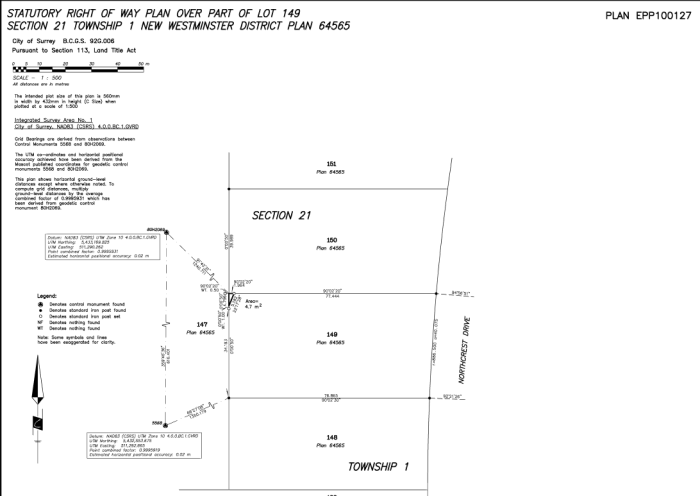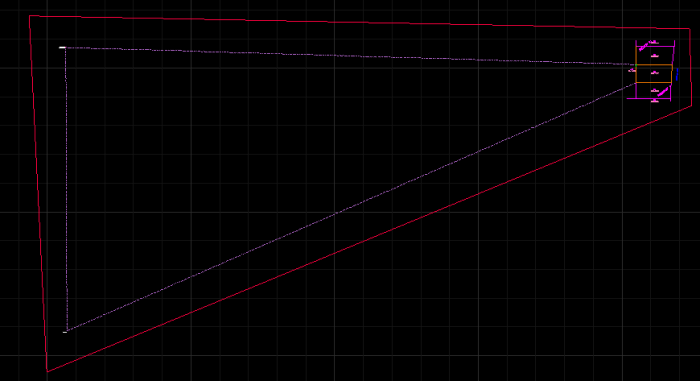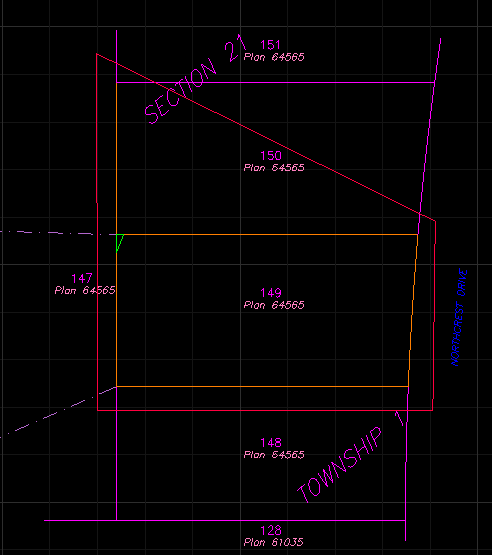- These guidelines have been prepared in support of Practice Bulletin No. 3: Surveyor General’s Requirements for the Submission of a Survey Plan Dataset to Support ParcelMap BC (“requirements”) and the ParcelMap BC Survey Plan Dataset Specifications (“specifications”). The purpose of these guidelines is to help land surveyors and their employee delegates reliably develop and submit survey plan datasets that comply with the requirements and expand on the specifications to safeguard the integrity of the land title and survey plan systems of British Columbia.
- To ensure your dataset submission is defect-free, review the most Common Survey Plan Dataset Defects and find out how to resolve them.
- Read Tips to Resolve Survey Plan Dataset Validation Errors when submitting a Survey Plan Dataset.
The Survey Plan Dataset Submission Process consists of three (3) components:
All spatial information that defines the Survey Plan (i.e. lines, arcs, annotations, natural boundaries etc.), as required by the Specifications.
Survey Data Control Point File
All control points shown on the Survey Plan, including Government Control Points (GCMs) listed in MASCOT and geo-referenced points derived by or referenced in the survey.
Survey Plan Metadata Submission Web Form (Accessible during the survey dataset upload submission process.)
Additional data that describes the Survey Plan (i.e. Survey Date, Plan Type, etc.), but is not addressed in these guidelines.
Optimizing the Survey Data CAD File
A CAD drawing file (in the .dwg CAD file format) that correctly expresses the real-world dimensions of the survey, as shown by the official plan of record, must be included.
- Drawing Format Requirements
- ParcelMap BC (PMBC) Layer Requirements
- Table 1 – ParcelMap BC (PMBC) Layers
- Ensuring Plan Integrity
- Guidelines for Special Plan Types:
Drawing Format Requirements
-
Individual CAD files are required for each new plan
For example, a new subdivision and a new easement cannot be submitted as one SPDS even if the plans are to be submitted to the registry concurrently.
-
Each CAD file should only include (on ParcelMap BC layers) the boundaries that are explicitly shown on the official plan of record
For an easement plan, this requirement means that the boundaries of the underlying subdivision parcels should only be included if they are required to locate the boundaries of the easement relative to the subdivision parcels.
- All surveyed lines shown on the official plan of record should be placed on one of the PMBC layers, including all resolved or retraced boundaries, even if they are not the subject of the plan (see instructions for PMBC_RESOLVED_LINES layer below).
-
All entities in the CAD file (e.g. lines, arcs, polylines, text, blocks, etc.) must be 2 dimensional (i.e. all Z values = 0)
- Do not use special CAD objects (e.g. Civil3d Alignments, Profiles, Corridors, Grading Lines, etc.) on PMBC layers. Convert them to simple lines, arcs and/or 2-D polylines instead.
- Circle entity types within the CAD file must be placed on the PMBC_OTHER layer
-
All line work in the CAD file (including non-PMBC layers) should be:
- Scaled to UTM grid distances using the Combined Scale Factor listed in the official plan of record. Inverse distances in the CAD file must be grid distances, not ground distances
- Shifted (translated) to the UTM NAD83 CSRS coordinates of the provided control points
- Rotated (if required) to ensure that inversed bearings in the CAD file are UTM grid bearings
- For Explanatory Plans, see the section on Special Plan Types for instructions on how to approximately georeference, scale, and rotate the plan to align with the Parcel Fabric.
-
While it is not necessary to define an explicit projection in the CAD file, if your software requires a projection to be defined for a drawing, ensure it is set to the correct UTM zone (and datum) for the survey
ParcelMap BC (PMBC) Layer Requirements
- There are nine (9) required PMBC layers. The names, content, and specifications for these layers are described in Table 1.
- All PMBC layers must be included in the CAD file, even if they are empty (i.e. no data is included)
- PMBC layers must be named exactly as specified below– all upper case (i.e. no lower case or mixed case, and no spaces)
- The layer colour, linetype, lineweight and other symbols used in the PMBC layers does not have to follow any particular specification and is entirely at the discretion of the surveyor. Mixed linetypes, line weights, and line colours can all be used within a PMBC layer.
- PMBC required data, linework, text, etc must be separated out into different layers according to the instructions in Table 1. Other entities in the CAD file that are not part of PMBC requirements can be left on non-PMBC layers or placed on the PMBC_OTHER layer.
- Polylines should only be used to represent the PMBC_SURVEY_LIMITS and natural boundaries. All other lines should be simple lines (2 point) and arcs.
Table 1 – ParcelMap BC (PMBC) Layers
- PMBC_SURVEY_LIMITS
- PMBC_PARCEL_LINE
- PMBC_INTEREST_LINE
- PMBC_DESIGNATION
- PMBC_TIE_LINE
- PMBC_ROAD_NAME
- PMBC_RESOLVED_LINES
- PMBC_DIM
- PMBC_OTHER
| Layer Name: | PMBC_SURVEY_LIMITS |
| CAD Entity Type: | 2-D Closed Polyline |
| Purpose: | A single, self-intersecting, closed polyline feature surrounding the total extent of the survey shown on the plan. |
| Guidelines: |
|
| Layer Name: | PMBC_PARCEL_LINE |
| CAD Entity Type: | Lines, Arcs, 2-D Polylines |
| Purpose: | Reserved for boundaries of the subject parcels of a plan (not including plans of easements, statutory right-of-ways, or other interests or charges). |
| Guidelines: |
|
| Layer Name: | PMBC_INTEREST_LINE |
| CAD Entity Type: | Lines, Arcs, 2-D Polylines |
| Purpose: | Reserved for boundaries of the subject parcels of an easement, covenant, lease or statutory right-of-way plan. |
| Guidelines: |
When submitting survey plan datasets consisting of easements split into multiple areas as shown on the book of reference, it is important to place the lines (highlighted in red) that delineate the areas on the PMBC_INTEREST_LINE layer and not on the PMBC_RESOLVED_LINES layer. Please see example below.
|
| Layer Name: | PMBC_DESIGNATION |
| CAD Entity Type: | Singleline or Multiline Text; Leaderlines |
| Purpose: | A text label uniquely describing a parcel within the plan. |
| Guidelines: |
|
| Layer Name: | PMBC_TIE_LINE |
| CAD Entity Type: | Lines, Arcs |
| Purpose: | Surveyed measurements that do not form part of the linear boundary of a survey parcel or interest. |
| Guidelines: |
|
| Layer Name: | PMBC_ROAD_NAME |
| CAD Entity Type: | Text |
| Purpose: | Road name, lane, road allowance and walk way text. |
| Guidelines: |
|
| Layer Name: | PMBC_RESOLVED_LINES |
| CAD Entity Type: | Lines, Arcs |
| Purpose: | Additional retraced or resolved parcel boundary lines that are not part of the subject parcels of a plan. |
| Guidelines: |
|
back to top of Survey Data CAD File
Ensuring Plan Integrity
- The linework on PMBC layers in the CAD file should directly correspond to the labeled dimensions shown on the official plan of record. If you inverse between the endpoints of a line in the CAD file, you should get the bearing and distance labeled in the plan (corrected for Combined Scale Factor and/or astronomic to grid bearing convergence angle).
- Surveyed lines, arcs, and natural boundary polylines should be broken into individual segments wherever they intersect with another surveyed boundary. This requirement does not apply to tie lines (on the PMBC_TIE_LINE layer) which are expected to cross other lines and boundaries without being broken. Surveyed boundary lines should also not be broken where they intersect unsurveyed 'scenery' lines on the PMBC_OTHER layer.
- All lines, curves and polylines on PMBC layers should 'snap' to each other perfectly, with no overshoots (lines that cross over each other) nor gaps (lines that do not quite meet at the parcel corner)
- If linework in the official plan of record has been 'clipped' to the outline of a placed survey post symbol (i.e. in order to 'mask' them), ensure that the lines have been extended to their true intersection in the PMBC layers
- Always use polylines to represent natural boundaries in a plan; never use them for surveyed (linear) boundaries
- Do not exaggerate or foreshorten lines included in PMBC layers – as specified above, all lines should be shown at their true length and bearing in UTM grid units
- All linework included on PMBC layers should be at the same scale – do not include details at a different scale than the main drawing
- Do not include overlapping or duplicate lines – there should only be one line connecting any two point locations on PMBC layers
- Ties to witness posts that are offset from the actual parcel boundary do not need to be included unless they are necessary to connect the parcels to control (deleting short tie lines to offset witness posts is recommended but not required)
- Dimensions for witness posts that fall on parcel boundaries are not required. The goal of ParcelMap BC is to represent the location of true parcel corners, not the location of physical survey monuments that reference those parcel corners (merging linework to include witness distances in the total line length is recommended but not required).
- Radial lines at the beginning and end of curve are not required
back to top of Survey Data CAD File
Guidelines for Special Plan Types
Please reference Practice Bulletin No 3: Surveyor General’s Requirements for the Submission of a Survey Plan Dataset to Support ParcelMap BC.
- Explanatory Plans
- Posting Plans
- Building Strata Plans
- Air Space, Volumetric Space, and Building Lease Plans
- External References
- Plans Prepared in Grid Distances (ABCLS Exemption under GSIR 3-4(1)(h))
Explanatory Plans
The georeferencing requirements for survey plan dataset (SPDS) submissions for Explanatory plans are outlined in Section 5 of Practice Bulletin No 3: Surveyor General’s Requirements for the Submission of a Survey Plan Dataset to Support ParcelMap BC.
-
If the Explanatory plan is prepared as part of a larger survey that has been georeferenced according to the instructions in Parts 2-2 of the Survey and Plan Rules, use the same georeferencing applied in that survey
- The SPDS for the Explanatory plan should only include (on PMBC Layers) the parcel or interest lines specific to the subject parcels of the Explanatory plan, along with resolved lines necessary to tie the subject parcel to the underlying georeferenced parcels. It is not necessary to include all the parcel lines from the underlying survey.
-
If the plan is being approximately georeferenced from the ParcelMap BC Fabric:
- Download the existing Parcel Fabric for area covered by the explanatory plan through LTSA Surveyor Search and Download
- Choose a boundary line that is common to both the explanatory plan being prepared and the download fabric, to use as a reference baseline for bearing and scale
- Shift/translate the CAD linework to one end of the selected baseline, in order to approximately georeference the CAD drawing to UTM coordinates
- Rotate the CAD linework to align with the selected baseline in order to establish approximate grid bearings for the drawing.
- If a true Combined Scale Factor for the area can be calculated, or derived from nearby control or georeferenced plans already in the Parcel Fabric, scale the drawing to UTM grid distances using that scale factor.
- If Combined Scale Factor is not known, use the length of the selected baseline to approximately scale the drawing to UTM grid distances.
- It is not necessary to include a Control .csv file for the selected PMBC parcel point(s) used to georeference the plan.
- When specifying the Relative Survey Accuracy of an Explanatory Plan in a Survey Plan Submission, use Level 6 (+/- 1m / 3600" / 1000PPM) unless it is part of a larger survey that has been accurately georeferenced (in the latter case, specify the same accuracy as the rest of the survey).
Posting Plans
- SPDS CAD files for Posting Plans should contain no linework on the PMBC_PARCEL_LINE or PMBC_INTEREST_LINE layer
- All resolved or retraced boundaries should be on the PMBC_RESOLVED_LINES layer, whether or not they belong to the subject parcel(s) of the Posting Plan
Building Strata Plans
General instructions for the preparation of SPDS CAD Files for Building Strata, Air Space, and Volumetric Space plans are outlined in Section 5 of Practice Bulletin No 3: Surveyor General’s Requirements for the Submission of a Survey Plan Dataset to Support ParcelMap BC. (see Note at bottom of Practice Bulletin)
- Include the perimeter boundary of the bare land extent of the strata development on the PMBC_PARCEL_LINE layer (typically, this is what is shown with a heavy black outline on the official plan of record)
- For Phased strata developments, only include the perimeter boundary of the current phase of the strata development on the PMBC_PARCEL_LINE layer (if the boundaries of previous phases have been resolved as part of the survey, include them on the PMBC_RESOLVED_LINES layer)
- Do not include any building outlines or offset lines to the building on any PMBC layers
- Do not include interior divisions of the strata development, including individual Common Property areas or individual Strata Lots, on any PMBC layers
Air Space Plan, Reference or Explanatory Plan of Volumetric Space (Interests), Building Strata Plans and Reference or Explanatory Building Lease Plans
General instructions for the preparation and submission requirements for datasets for Air Space plans, Volumetric Space and Building Strata plans are outlined in a Note at the bottom of Section 5 in Practice Bulletin No 3: Surveyor General’s Requirements for the Submission of a Survey Plan Dataset to Support ParcelMap BC.
- To provide further clarity, please review the following. Within ParcelMap BC, parcels and interests which would be too complex to map completely due to their three dimensional and potential overlapping geometries are depicted as a simple schematic representation, using the geometry of the parent parcel to indicate their general location without details of the complex internal divisions.
- In addition to the plan types listed in Practice Bulletin No 3 a similar approach should also be applied to Explanatory or Reference plans of Building Leases of interior spaces of buildings. These interior spaces defined by rooms, hallways, mechanical/electrical closets and by floors or levels within a building are also too complex to try and map and instead the dataset should be submitted as just the parent parcel they are contained within.
- For an Air Space parcel: include the perimeter boundary of the parent parcel on the PMBC_PARCEL_LINE layer.
- For a Volumetric Easement, Volumetric SRW, Building Lease of an interior area, or any other interest with a complex three dimensional component: include the perimeter boundary of the titled parcel over which the charge is being raised on the PMBC_INTEREST_LINE layer.
- Do not include any detail of interior divisions of an Air Space, Volumetric Space, Building Strata or Building Lease of an interior area on any PMBC layer.
An exception to the rule is for a Lease defined by the exterior perimeter of an entire building or building foundation situated where we would expect to receive the extent of this lease area fully defined and outlined on the PMBC_INTEREST_LINE layer.
- Note that the plan type for a Volumetric interest (including a Lease of a Building) in your Survey Plan Submission should be Section 99 - Volumetric (not Section 99 - Charge).
- If the parent parcel boundaries were not entirely resolved during the survey of the volumetric space, provide the best available representation of the parent parcel on the PMBC_PARCEL_LINE (for an Air Space) or PMBC_INTEREST_LINE (for Volumetric Interests) layer:
- In the case of a parent that is separated into a number of distinct parts, use the perimeter boundary of the local part over which the Air Space or Volumetric Interest lies
- Scenery linework, or linework copied from another plan, can be used to represent the parent if necessary. In such cases, the Accuracy of the Survey Plan Submission should be defined as Level 6 (+/- 1m / 3600" / 1000 PPM) to indicate that not all parcel boundaries have been accurately resolved.
Plans Prepared in Grid Distances (ABCLS Exemption under GSIR 3-4(1)(h))
- It is still necessary to provide an Average Combined Scale factor in the Survey Plan Submission. PMBC stores parcel geometry in grid coordinates but applies a CSF to calculate ground distances for the entire fabric.
- Ensure that the supplied CSF is in the ground-to-grid direction, not the grid-to-ground direction.
Plans Containing Natural Boundaries
- In cases where a survey plan shows creeks, you may draft a centerline only on your PDF due to scale considerations, however, please include the full detail of the creek on the PMBC_PARCEL_LINE layer within the dataset submission i.e. include both sides of a creek. This will facilitate the fabric operations team to exclude the area below the natural boundary from the resulting block parcel, while including the bed of the creek in the DL.
-
The following is an example from plan EPC1950, where only the centerline is shown on the plan (left image) however, the expectation is the dataset would include both sides of the creek (right image) on the PMBC_PARCEL_LINE layer
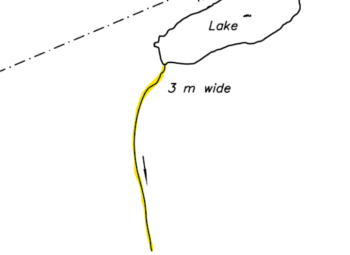
Plan EPC1950 
Plan EPC1950 Dataset -
In cases where a survey plan consists of islands (see image below) and as a workaround to pass the structure validation check, ensure that the polyline depicting the present natural boundary on the PMBC_PARCEL_LINE layer is split into at least three segments to prevent a validation error during dataset submission.
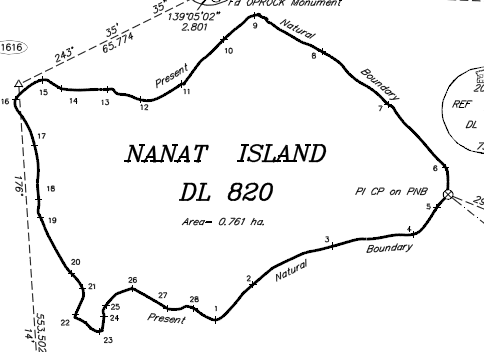
Plan EPC1777
External References
- A-1 Association of BCLS: Survey and Plan Rules V1.2- November 14, 2019
- A-2 Surveyor General Circular Letters, LTSA, specifically Circular Letter No. 463: Official Horizontal Datums for Georeferencing Legal Surveys in British Columbia
- A-3 Practice Bulletin No 3: Surveyor General’s Requirements for the Submission of a Survey Plan Dataset to Support ParcelMap BC
- A-4 Parcel Map BC: PMBC-RS-53-6939 Survey Plan Dataset Specifications
back to top of Survey Data CAD File
Optimizing the Survey Data Control Point File
A .csv (comma-separated value) formatted text file describing the required geo-referenced control points must be included:
- The file name must be saved with a .csv extension
- The structure of the file is based on a standard PNEZD points file, with the addition of extra fields to record information about the Positional Accuracy of the control point
- Each line in the file must contain exactly ten (10) comma-separated fields, even if no value is provided. The table below describes the content of these fields
- Do not include a header line in the file – only include the actual control point data
- The Control points for a survey plan submission are the (minimum) two georeferenced points required under GSIR rule 2-6(1).
- Do not include any control points that are not shown within the official plan of record.
- Do not include coordinates of survey posts (such as iron pins, lead plugs, or capped posts) unless they are labelled in the plan.
- Do not include the coordinates of an Active Control GNSS Reference Station.
- Additional details about control point requirements can be found in the following references:
- Section 7 of Practice Bulletin No 3: Surveyor General’s Requirements for the Submission of a Survey Plan Dataset to Support ParcelMap BC
- Parts 2-2 of Survey and Plan Rules V1.2- November 14, 2019
- Circular Letter No. 463: Official Horizontal Datums for Georeferencing Legal Surveys in British Columbia
Sample Survey Data Control Point File
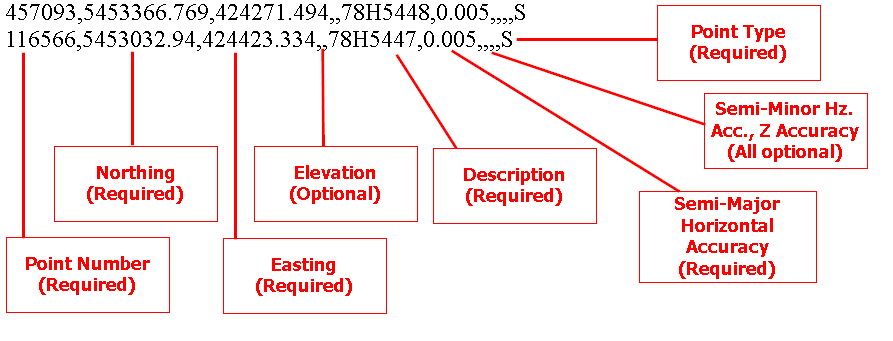
Table – Survey Data Control Point File Description
| Data Element | Field Position | Status | Meaning |
| Point Number | 1 | Required |
Unique numeric identifier for the control point
|
| Northing | 2 | Required |
Northing (Y-coordinate) in UTM grid units
|
| Easting | 3 | Required |
Easting (X-coordinate) in UTM grid units
|
|
Elevation (Orthometric Height) |
4 |
Optional |
Height above geoid
|
| Description | 5 | Required |
Short text description that uniquely identifies point within plan
|
| Horizontal Accuracy (Semi-Major) | 6 | Required for Survey Control Points |
Estimated Horizontal Position Accuracy (EHPA) of a Survey control, in metres
|
| Horizontal Accuracy (Semi-Minor) | 7 | Optional |
If EHPA is expressed as an error ellipse: the Semi-minor axis of the ellipse at a 95% confidence level (in metres)
|
| Horizontal Accuracy Angle | 8 | Optional |
If EHPA is expressed as an error ellipse: the Azimuth of the semi-major axis of the ellipse (in decimal degrees)
|
| Z Accuracy | 9 | Required if Elevation included |
If Elevation has been provided: the Estimated Vertical Positional Accuracy at a 95% confidence level (in metres)
|
| Point Type | 10 | Required |
A coded value indicating the origin of a control point
'V' (Vertical) is a vertical benchmark that is listed in MASCOT and is included in ParcelMap BC as reference. |
